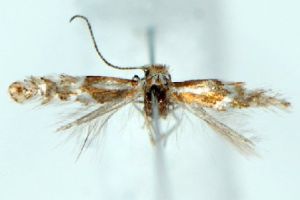2. Diagnose
2.1. Falter
4. Weitere Informationen
4.1. Etymologie (Namenserklärung)
Die Etymologie ist so offensichtlich, dass Varenne & Nel (2016: 56-57) sie in ihrer Originalbeschreibung gar nicht erklären. Das Art-Epitheton corsica, Name der Mittelmeer-Insel, ist ein Substantiv in Apposition.
4.2. Taxonomie
Huemer & van Nieukerken (2021: 311) bestätigen den Artstatus des Taxons: "The full DNA barcode of the holotype with ca. 5.5% divergence to the nearest neighbour in BOLD, P. eugregori Laštůvka & Laštůvka, 2006 supports a separate species status, possibly as an endemic species for Corsica, feeding on a species of broom."
(Autor: Erwin Rennwald)
4.3. Typenmaterial
Varenne & Nel (2016: 56) beschrieb die Art nach einem einzigen ♂: « HOLOTYPE mâle : Haute-Corse, Calacuccia, 960 m, 4 août 2015, uv, Th. Varenne leg., prép. gen. JN n° 29354, Coll. Th. Varenne (Nice). »
4.4. Literatur
- Huemer, P. & E. van Nieukerken (2021): Identity of some recently described Lepidoptera from France — re-assessed with DNA barcodes and morphology. — Zootaxa 4941 (3): 301–337. [zum open-access-Artikel und PDF-download auf mapress.com]
- Erstbeschreibung: Varenne, T. & J. Nel (2016): Description de cinq nouvelles espèces de Lépidoptères découvertes en Corse : Trifurcula angustivalva sp. n., Trifurcula aureacorsa sp. n., Infurcitinea restonicae sp. n., Phyllonorycter corsica sp. n. et Sorhagenia orocorsa sp. n. (Lepidoptera, Nepticulidae, Tineidae, Gracillariidae, Cosmopterigidae). — Revue de l'Association Roussillonnaise d'Entomologie 25 (1): 51-59.







